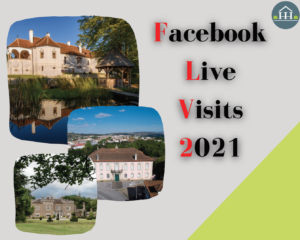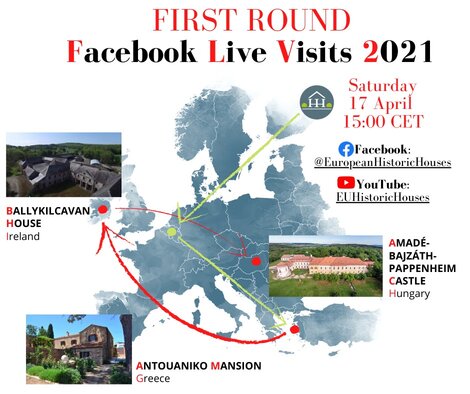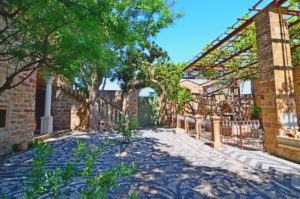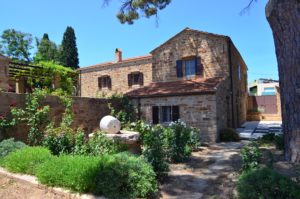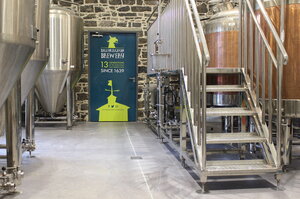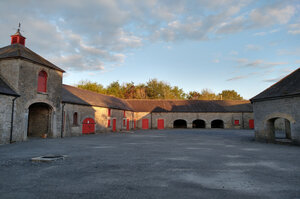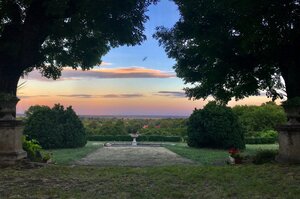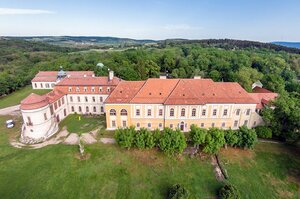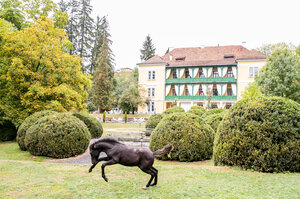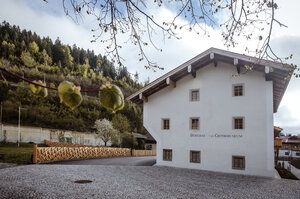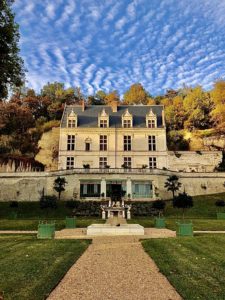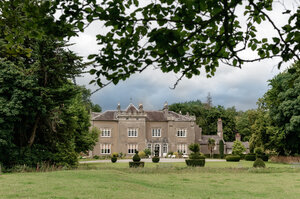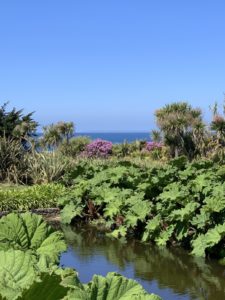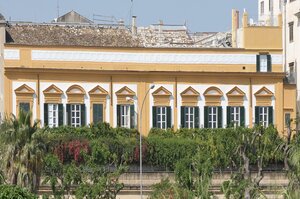Rewatch the 2021 season of Facebook Live Visits on our Youtube Page and stay up to date on the next edition !!!
Facebook Live Visits 2.0
European Heritage Weeks – Facebook Live Visits 2021
Given the success of last year’s virtual edition of the event and see the extension of the travel restriction measures across Europe, this spring the European Heritage Weeks took place online once again.
The format did not change: over four weekends between April and May, some private owners from different corners of Europe opened and presented their historic houses on the EHH social media through short virtual live guided tours. In this way, the owners were able to promote and enhance their houses even during this difficult period while people from all around the world had the chance to travel and discover our invaluable European private heritage sites while staying at home.
This year, the virtual visits have been broadcasted live simultaneously on both Facebook and YouTube.
On Saturday the 17th of April at 15:00 CET, the first round of the event took place and three houses have been presented: Antouaniko Mansion (Greece), Ballykilcavan house (Ireland) and Amadé-Bajzáth-Pappenheim castle (Hungary). The first round of live tours has been introduced by the EHH Executive President, Alfonso Pallavicini. The participants in the following rounds were from Finland, Romania, Austria, France, Portugal, Italy and Sweden. While waiting impatiently for being able to physically travel again, follow all the updates about our flagship event on this website and Facebook page . Do not miss this great opportunity to travel around Europe while remaining at home!
First Round (17th of April):
15:00 – Antouaniko Mansion (GREECE) – Presented by Manolis Vournous
Antouaniko is a characteristic mansion of Kambos area, on the aegean island of Chios, in Greece. The estate comprises a historic tangerine and orange trees plantation, together with the main house, the pebbled yard, the irrigation system and auxiliary buildings. Mansions in Kambos were first created in the Genoese period, until the mid 16th century. The area flourished in the Ottoman years to reach a new heyday at the end of 19th century.
FACEBOOK: Μανώλης Βουρνούς (14) Μανώλης Βουρνούς | Facebook
(14) Κατερίνα Μανωλιάδη – Μανώλης Βουρνούς | Facebook
INSTAGRAM: Μανώλης Βουρνούς (@manolisvournous) • Φωτογραφίες και βίντεο στο Instagram
M+B ΑΡΧΙΤΕΚΤΟΝΕΣ (@mvarchitects) • Φωτογραφίες και βίντεο στο Instagram
TWITTER: @ManolisVournous LINKEDIN: Manolis Vournous
15:20 – Ballykilcavan House (IRELAND) – Presented by David Walsh-Kemmis
Ballykilcavan Brewery is based on Ballykilcavan Farm in the heart of Ireland. The farm has been the home of the Walsh family for 13 generations since 1639. The brewery is installed in a renovated 240 year old grain store, and the family are currently converting two adjoining buildings into a visitor centre and tasting room.
On social media, we are @ballykilcavan on twitter, facebook and instagram.
15:40 – Amadé-Bajzáth-Pappenheim Castle (HUNGARY) – Presented by Ari S. Kupsus
The oldest part of the Amadé-Bajzáth-Pappenheim castle was build up in 1700 and every generation added some wings and parts. The whole estate was socialized from Count zu Pappenheim and his family in 1945 and after that looted totally. Till 1980 the chateau was used for different purposes; military hospital, school, post office, police, local government offices, movie theatre, pharmacy, apartments etc. In 1982 the Hungarian State emptied the chateau because the building was in life danger state. Some renovations took place but there was no use for the chateau after it was renovated. The main building (in the former children wing there is still local primary school working) was left empty and abandoned for thirty years. In 2012 Mr Ari Kupsus rented the empty chateau from the Hungarian State and started to save this wonderful cultural heritage and fill it’s walls with pieces of antique and culture. Today the chateau is the only chateau in Hungary that has been decorated for the living purposes with the periodical furniture, paintings and decoration items, all from the 1760-1860’s.
FACEBOOK: https://www.facebook.com/Amad%C3%A9-Bajz%C3%A1th-Pappenheim-chateau-273935819373187/
Second round (24th of April):
15:00 – Wiurilan Kartano (FINLAND)
Wiurila Manor is in southwestern Finland. Wiurila Manor is mentioned in historical records as early as the 15th century . In the late 18th century the manor was acquired by the renowned Arminoff family. Anne Marie Aminoff is the 7th owner from the family.
15:20 – Zabola Estate (ROMANIA)
The history of the Mikes Estate of Zabola dates back to the 15th century and has been in constant change since than due to the turmoil of Transylvanian history. In 1949 the estate was nationalized, and the family thrown out. The castles went through a row of functions starting from being the holiday home of the Communist National Press Association, school and sanatorium. The property was revendicated by the Roy-Chowdhury family (the successors of the Mikes’) in 1999. Some of the buildings together with the surrounding widespread English garden currently serves as a boutique hotel.
15:40 – Bergau-Und Gotikmuseum Leogang (AUSTRIA)
Shankill Castle in Co Kilkenny, Ireland, is the home of artist Elizabeth Cope. Both traditional and eclectic, the house is filled with antiques as well as contemporary art. The castle originated as a tower house, but was rebuilt in the Queen Anne period by Peter Aylward in 1708. It was extended and castellated in 1850, and sits within landscaped gardens.
16:00 – Botanical Garden of Vauville (FRANCE)
At the end of the Cotentin (Normandy), against all odds, hides an incredible oasis of over 1,000 species of plants from the southern hemisphere. Covering more than 4.5 hectares (10 acres), the Botanical Garden of Vauville is a journey into the world under the Norman latitudes: around the magnificent castle (from the XIIth and XVIth Century) walk through a succession of green rooms as exotic and surprising, discover the palm groves of trachycarpus fortunei from China, the moats and their royal ferns from Tasmania, the impressive pool of gunneras manicata from Brazil, the eucalyptus in the “garden of wisdom” or the scents of the “exotic garden”.
Final Round (8th of May):
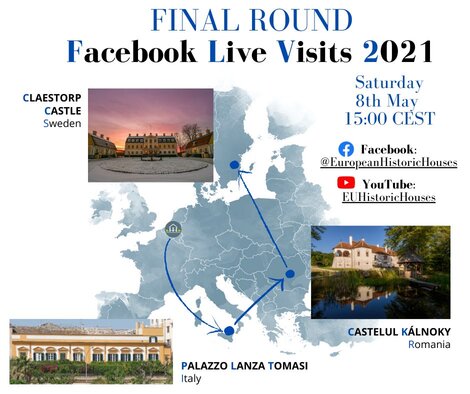
15:00 – Palazzo Lanza Tomasi (ITALY)
Palazzo Lanza Tomasi overlooks Palermo’s stunning seafront. It was built at the end of the 17th century atop the 16th century Spanish city walls. The palazzo was the last home of Prince Giuseppe Tomasi di Lampedusa, the celebrated author of “The Leopard”. His adopted son, Gioacchino Lanza Tomasi, unified the whole property and lovingly restored it. The palazzo houses the historical library of the author, a series of documents and portraits of his family as well as all of his manuscripts, including the original manuscript of “The Leopard”.
15:20 – Kálnoky Castle (ROMANIA)
Tibor Kálnoky, who belongs to the 25th generation of this historical family from Micloșoara, decided to leave the West where he was born to establish himself in Romania, where in turn his family was exiled from during the communist period. His goal was to save his family’s valuable architectural heritage, a castle comprising several different properties which evolved from an ancient estate probably built by Bálint Kálnoky around the end of the 16th century.
15:40 – Claestorp Castle (SWEDEN)

